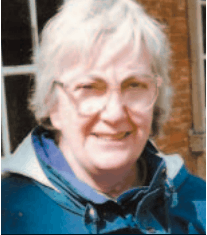Cicely Pearl Blair
| Cicely Pearl Blair MRCS LRCP, MRCP, FRCP | |
|---|---|
 Cicely Blair | |
| Born |
20 May 1926 Huddersfield, West Yorkshire |
| Died |
14 February 2005 (aged 78) London |
| Fields | Dermatology |
| Spouse | Henry Blair (m. 1954–84) |
Cicely Pearl Blair (née Hopton; 20 May 1926 – 14 February 2005) was a British dermatologist. She discovered that people who had albinism did not get blackheads, as they did not produce melanin, the pigment that makes the comedones black. She also wrote about rashes caused by brown-tailed moth caterpillars. After her retirement, she turned her hand to art and especially silver smithing, fashioning a "chain of office" for the president of the British Association of Dermatologists.
Early life
Blair was born Cicely Pearl Hopton on 20 May 1926 in Huddersfield, West Yorkshire. Her father, John Isaac Hopton, and her mother were both teachers.[1] She attended Greenhead High School in Huddersfield before studying at the Royal Free Hospital School of Medicine in London. In 1951, she qualified as a medical practitioner, gaining posts first at the Royal Free Hospital and then at the London Jewish Hospital.[1] In 1954, she married Henry Blair and the couple moved into general practice in Chingford, East London and remained in the role for 15 years.[2] In 1969, the couple left general practice to focus on research, Cicely in dermatology and Henry in allergies.[2]
Dermatology

Blair left general practice in 1969 to focus on the study of dermatology. Over the next few years, she worked in a number of roles including a spell as a research assistant at St Bartholomew's Hospital. Whilst at St Bartholomew's, she focussed on acne research, discovering that the pigment in blackhead comedones is melanin and therefore that patients with albinism did not suffer from blackheads.[1]
In 1974, she became a consultant at Oldchurch Hospital in Romford.[1] There she continued her research, at one point publishing a paper on rashes which could be caused by caterpillars of the brown-tailed moth.[2] Whilst at Oldchurch, Blair took an active interest in fundraising for the dermatology department. She is credited with setting up a number of events, which allowed the department to purchase an expensive PUVA machine.[2]
Retirement
Blair's husband, Henry, died in 1984 and as the couple had not had any children, she was free to focus on her own interests when she retired.[3] She became an amateur silversmith, winning prizes for her sculptures[3] and going on to make the "chain of office" for the president of the British Association of Dermatologists.[2] She joined the Medical Art Society as a painter and spent time photographing flora and fauna, especially in the Galapagos and Falkland Islands.[2][3] Blair died aged 78 on 14 February 2005 in London after an accident.[3]
Works
- Baker, Harvey; Blair, Cicely P. (6 June 1968). "Cell replacement in the Human Stratum Corneum in old age". British Journal of Dermatology. 80 (6): 367–372. doi:10.1111/j.1365-2133.1968.tb12322.x. Retrieved 7 January 2016.
- Blair, Cicely (7 July 1968). "Morphology and thickness of the human stratum corneum". British Journal of Dermatology. 80 (7): 430–436. doi:10.1111/j.1365-2133.1968.tb11978.x. Retrieved 7 January 2016.
- Blair, Cicely (8 August 1968). "The thickness of the stratum coeneum in acne vulgaris". British Journal of Dermatology. 80 (8): 516–519. doi:10.1111/j.1365-2133.1968.tb12340.x. Retrieved 7 January 2016.
- Lewis, C.A.; Blair, Cicely (6 June 1970). "The Pigment of Comedones". British Journal of Dermatology. 82 (6): 572–583. doi:10.1111/j.1365-2133.1970.tb06098.x. Retrieved 7 January 2016.
- Blair, Cicely (3 September 1970). "Angiokeratoma of the Vulva". British Journal of Dermatology. 83 (3): 408–411. doi:10.1111/j.1365-2133.1970.tb15727.x. Retrieved 7 January 2016.
- Blair, Cicely (2 February 1976). "The action of a urea—lactic acid ointment in ichthyosis". British Journal of Dermatoloy. 94 (2): 145–153. doi:10.1111/j.1365-2133.1976.tb04363.x. Retrieved 7 January 2016.
- Blair, Cicely P. (2 June 1979). "The browntail moth, its caterpillar and their rash". CLINICAL AND EXPERIMENTAL DERMATOLOGY. 4 (2): 215–222. doi:10.1111/j.1365-2230.1979.tb01621.x. Retrieved 7 January 2016.
- Blair, Cicely (2 April 1982). "The dermatological hazards of bowling Contact dermatitis to resin in a bowisgrip". Contact Dermatitis. 8 (2): 138–139. doi:10.1111/j.1600-0536.1982.tb04163.x. Retrieved 7 January 2016.
References
- 1 2 3 4 Gillam, Sarah. "Cicely Pearl Blair". Lives of the fellows. Munk's Roll. Royal College of Physicians. XII. Retrieved 7 January 2016.
- 1 2 3 4 5 6 Salisbury, Jennifer (2005). "Cecily Blair" (PDF). British Association of Dermatologists (Winter Newsletter). Retrieved 7 January 2016.
- 1 2 3 4 Lawrence, Ida (12 March 2005). "Cicely Pearl Blair (née Hopton)". British Medical Journal. 330 (7491). PMC 554047
 .
.